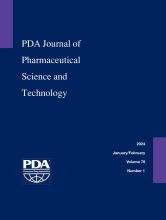Abstract
The manufacturing of a wide range of biopharmaceuticals, from antibodies and vaccines to cell-based therapies, increasingly takes place in single-use processing equipment. Manufactured in clean rooms and sealed and sterilized, single-use systems (SUSs) are ready-to-use and easily scalable. Controls in the “clean-build” manufacturing of SUSs reduce the probability of occurrence of particulate matter in SUSs. However, the size, complexity, and limited transparency of SUSs clearly limit the detectability of particulate matter on the interior (fluid-contacting) surfaces of a SUS during a visual inspection, as demonstrated in a recent study. In applications downstream of final filters or in aseptic processing, particulate matter on the surfaces of a SUS could detach and contaminate the final drug product. A realistic assessment of this risk requires reliable test methods that quantify and identify particulate matter present on the interior surfaces of SUSs. Clearly problematic is the common certification of the cleanliness of a SUS via a force-fit adaptation of the pharmacopeial standard USP <788> entitled “Particulate Matter in Injections”. USP <788> does not describe a procedure for extraction of particulate matter from the interior surfaces of SUSs. In addition, application of Method 1 Light Obscuration significantly limits the probability of detection for particles in the visible size range (≥ 100 µm). In this article, we describe best practices for extracting, counting, sizing, and chemically identifying particulate matter on the interior surfaces of SUSs. Highly effective procedures for the extraction of particulate matter result from application of the qualification methodology described in a recently published ASTM standard. Filtration of the liquid extract concentrates particulate matter onto the surface of a membrane filter, allowing rapid particle counting and sizing using automated membrane microscopy, along with detailed chemical identification using infrared microscopy and/or automated confocal Raman microscopy.
- © PDA, Inc. 2024
PDA members receive access to all articles published in the current year and previous volume year. Institutional subscribers received access to all content. Log in below to receive access to this article if you are either of these.
If you are neither or you are a PDA member trying to access an article outside of your membership license, then you must purchase access to this article (below). If you do not have a username or password for JPST, you will be required to create an account prior to purchasing.
Full issue PDFs are for PDA members only.
Note to pda.org users
The PDA and PDA bookstore websites (www.pda.org and www.pda.org/bookstore) are separate websites from the PDA JPST website. When you first join PDA, your initial UserID and Password are sent to HighWirePress to create your PDA JPST account. Subsequent UserrID and Password changes required at the PDA websites will not pass on to PDA JPST and vice versa. If you forget your PDA JPST UserID and/or Password, you can request help to retrieve UserID and reset Password below.






